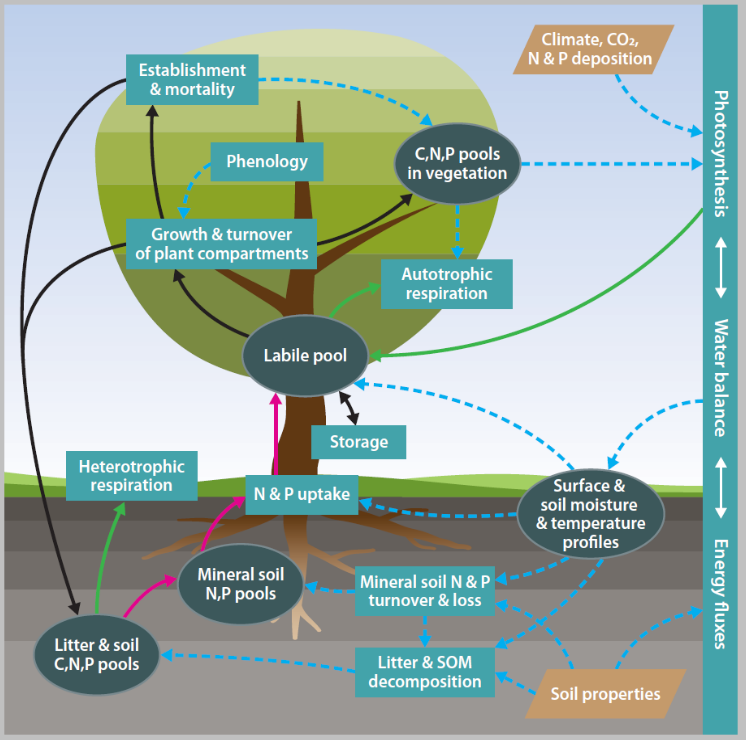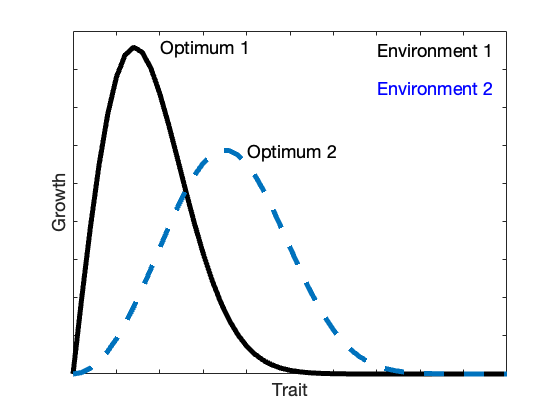Research
 The QUINCY model
The QUINCY model
“QUINCY (Quantifying the effects of interacting nutrient cycles on terrestrial biosphere dynamics and their climate feedbacks) is a newly developed land surface model with fully coupled carbon, nitrogen, phosphorus and water cycles. QUINCY is built in a modular fashion, and is the ideal tool to test out new hypotheses and model processes. We of course have some new scientific features as well, such as the ability to track carbon and nitrogen isotopes, a short and long-term plant storage pool and decoupling photosynthesis from growth.
You can find the model description paper here and you can request access to the model code here.
 Optimality principles
Optimality principles
Often the inclusion of additional processes in models is synonymous with the addition of a large number of difficult to constrain parameters, so that the apparent improvement in model performance is cancelled by the increased uncertainty 31. Optimality theory offers an elegant mathematical solution to this problem. The theory states that plants aim to maximise their growth, survival and offspring fitness by adjusting their physiology and structure in response to biotic and abiotic factors in their environment. We have worked on a variety of optimality models, including optimal leaf nitrogen content under elevated CO2 (in this paper) and a generic model for leaf phenology (in this paper).
 Using manipulative experiments with process-based models
Using manipulative experiments with process-based models
Manipulative ecosystem experiments are broadly defined as outdoor experimental setups in which one or multiple driving factors, or a combination of factors, are controlled to study their effects on ecosystem level processes. Such experiments are often highly instrumented and can provide data on a variety of ecosystem processes at high temporal resolution in a relatively controlled environment. As such, they are an ideal tool for improving process representation in mechanistic models. This is a common thread through our past and current work and you can read more on how we can best use experiments with models here.
Projects
E-PATH: Ecological Forecasting of Tree Resistance to Pathogens: Ash Dieback and Beyond
Funder: EPA
Team members: Carmen Watkins
Outbreaks of plant diseases, such as the recent widespread effects of ash dieback in Ireland and across Europe, pose a major threat to both natural and managed habitats. With the inevitable advancement of climate change, both the risk of new pathogens and plant susceptibility are likely to increase. This will be compounded by abiotic stressors such as drought, heat, and extreme rainfall, making plants more vulnerable to new infections. Therefore, it is critical that we have the tools needed to forecast such outbreaks and take short- and medium-term decisions about landscape management. In this project, we will build an ecological forecasting tool based on plant eco-physiological models, with an aim to provide localised, short-term information on the probability and degree of infection and to what extent a tree can survive. The project is in collaboration with Dr. Dheeraj Rathore (Teagasc) and will integrate molecular and physiological data collection with model development.
Trait-Tweaks: Exploring Ecological Realism in Ecosystem Models under Future Climate Conditions

Funder: Research Ireland
Team members: Camille Abadie, Luke Daly
Land surface models (LSMs) have made significant advances in incorporating biologically realistic processes but are still far from adequately representing plant responses to changes in climate or atmospheric CO2. Plants are fundamentally plastic, and respond flexibly to their environment, both at short timescales through plasticity and across multiple generations through evolution and competition, processes currently not incorporated in LSMs. Trait-Tweaks will bridge this gap by creating the first model to include theoretical concepts from biogeochemistry and evolutionary ecology. The project brings together complementary data sources from existing experimental networks, and global trait databases. Large datasets of plant traits provide a wealth of information but are often limited to statistical analyses. trait-tweaks will shift the way we work with plant traits by providing process understanding and testable hypotheses for global trait distributions.
Climate + biodiversity + water Co-centre

Funder: Research Ireland/DAERA/UKRI
Team members: Gayathri Girish Nair
Climate + biodiversity + water is a joint research centre between academic institutions in Ireland, Northern Ireland and Great Britain as well as multiple industry partners. We aim to tackle the joint global crises of climate change, biodiversity loss and water degradation from both a fundamental science point of view and applied and policy perspective. The PEM group is actively involved in Platform 1: Projections and working on future predictions of the carbon cycle under changes in climate and land use and novel ways to integrate biodiversity into land surface models.
PhenoShift: Phenology as a growth and survival strategy in a changing climate
Trinity Research Doctorate internal funding
Team members: Midori Yajima
Leaf phenology - the timing of leaf on and leaf off - is still largely viewed as phenomenon driven by temperature. However, leaf seasonality is not restricted to ecosystems where temperature is the main seasonal driver, it is a process taking place in most ecosystems, including tropical and subtropical seasonally more or less dry systems. The projects integrates new developments in QUINCY with data from remote sensing, eddy covariance, phenocams and citizen science.
Grassland carbon dynamics and management in a next generation land surface model
iCRAG SFI research centre
Team members: Josua Seitz
Grasslands are one of the major global ecotypes, both in terms of area and carbon storage capacity and can also be significant sources of other greenhouse gases due to management for human use (e.g. grazing, fertilisation). This project will investigate how grassland carbon, nutrient and water cycles change globally under future conditions and how climate and management practices interact to alter these cycles. The project builds realistic physiological and ecological knowledge specific to herbaceous plants into QUINCY, looking at processes such as turnover and reproductive growth and diferentitation between annual and perennial ecosystems.